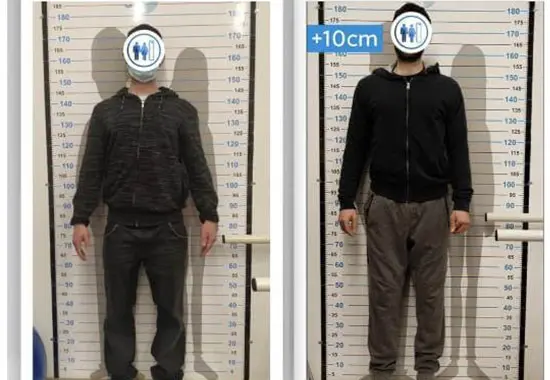Limb Lengthening Surgery
Get a QuoteBy Bahar Ozbal • Medical review by Muharrem Inan, MD on February 08, 2021
Get a Quote
Quick Facts

It is the result of a limb-lengthening surgery performed by Wanna Be Taller. For reference purposes only, results may vary.
Limb Lengthening Surgery Before & After PhotosDoctors
Most Active Doctors on NewMe
Real Reviews
Most Related Review
Are there any risks to limp lengthening surgery?
Is there a risk of paralysis in limp lengthening surgery?
Read MoreI want to limb lengthening and i need to advice
Hello I am 171 cms 83.5 kg. I am planning to go to Turkey at the end of summer. I would like some info about Drs who do limb lengthening with Lon method. I would like to see packages including 90 days stay in Turkey. Thanks in advance
Read MoreI have spina bfida, my size 1.45, can I be operated?
Hello. I am 22 years old and I have spina bfida. I'm at 1.45 and it's ruining my social life. I want limb lengthening surgery, but I have muscle sensitivity due to my illness. How accurate is it to have surgery? Is there a drug treatment? Thank you.
Read MoreI had some problems after limb lengthening surgery, it’s getting better slowly. Are there any exercises I can do to speed up the process?
<p><meta charset="utf-8" />Hello, I had surgery for genu varum and then I had a cosmetic limb lengthening procedure. Yes, I got taller with the surgery, and the fixators have been on my leg for 10 months but unfortunately, my physical therapy process didn’t go well. My calf muscles are short, I have contractures in my knees and I have lower leg syndrome. I do my exercises constantly but the progress is extremely slow. Do you have any suggestions for me?</p>
Read MoreDoes limb lengthening surgery make you disproportionate?
<p dir="ltr">Hello. I’m 168 cm tall and I want to have surgery to get 10 cm longer. Will there be any noticeable disproportion in the body as a result of the surgery? </p>
Read More
Are there any risks to limp lengthening surgery?
Is there a risk of paralysis in limp lengthening surgery?
Read More
I want to limb lengthening and i need to advice
Hello I am 171 cms 83.5 kg. I am planning to go to Turkey at the end of summer. I would like some info about Drs who do limb lengthening with Lon method. I would like to see packages including 90 days stay in Turkey. Thanks in advance
Read More
I have spina bfida, my size 1.45, can I be operated?
Hello. I am 22 years old and I have spina bfida. I'm at 1.45 and it's ruining my social life. I want limb lengthening surgery, but I have muscle sensitivity due to my illness. How accurate is it to have surgery? Is there a drug treatment? Thank you.
Read More
I had some problems after limb lengthening surgery, it’s getting better slowly. Are there any exercises I can do to speed up the process?
<p><meta charset="utf-8" />Hello, I had surgery for genu varum and then I had a cosmetic limb lengthening procedure. Yes, I got taller with the surgery, and the fixators have been on my leg for 10 months but unfortunately, my physical therapy process didn’t go well. My calf muscles are short, I have contractures in my knees and I have lower leg syndrome. I do my exercises constantly but the progress is extremely slow. Do you have any suggestions for me?</p>
Read More
Does limb lengthening surgery make you disproportionate?
<p dir="ltr">Hello. I’m 168 cm tall and I want to have surgery to get 10 cm longer. Will there be any noticeable disproportion in the body as a result of the surgery? </p>
Read MoreAll About Limb Lengthening Surgery
What is Limb Lengthening Surgery ?
Limb lengthening surgery, (surgery to get taller) with more known name leg lengthening surgery or height surgery is a long-termed and hard surgery as well, involving a 6-12 months treatment process.
In limb lengthening surgery of which the first stage is completed under general anesthesia by Orthopedics and Traumatology Doctors, the bone to be lengthened is cut first and an "External Fixator Device" is inserted around the opened bones.
By the help of the External Fixator Device, bone is opened 1 mm daily and a cavity in the bone is provided. Bone cavity opened is filled with bone tissue slowly and new bone formation occurs. External Fixator Device is removed with a small operation after bone hardening.
What Is The Price Of Limb Lengthening Surgery?

Limb Lengthening Surgery is planned exclusive to individuals. Many details such as the technique to be applied, the process of treatment, hospitalization, the orthopedic surgeons selected, the city and district where the operation will be performed are the factors affecting the Limb Lengthening Surgery price.
How Much Is A Limb Lengthening In Turkey?
Limb Lengthening in Turkey is cost-effective and hygienically, a contrast to other countries:
LON: 21,400$ Precice 2: 44,850$
How Is Limb Lengthening Surgery Operated?

In cases of dwarfism, the target length is 1.50 cm for females and 1.60 cm for males in limb lengthening surgery. In the case of limb lengthening surgery for aesthetic purposes, the target length is determined according to the request of the person.
Limb Lengthening Surgery is planned exclusive to individuals. The expectation of the person, joint motion gap, the condition of the muscles and the capacity of the bone are considered to be important in this planning.
Limb Lengthening Surgery is operated through 3 methods: Intra-bone, extra-bone and combined system...
The intra-bone method is preferred in aesthetic Limb Lengthening Surgery; while health-based lengthening operations such as dwarfism are performed by the extra-bone method.
Ideally accepted Limb Lengthening Surgery method is the one performed both with intra-bone and external-bone interventions, called combined method and surgeries of which the recovery process is more comfortable and faster.
Limb Lengthening Surgeries are operations that last 1-1.5 hours under general anesthesia. Postoperative treatment duration varies depending on the target length and daily rate of lengthening. The expected daily lengthening rate of Limb Lengthening Surgery is 1 mm.
This target millimeter can be reduced or increased depending on the quality of bone formation. If an average of 1 mm lengthening per day is assumed, the time to reach a person's target cm is planned based on this target value.
In other words, if the person targets for a lengthening of 5 cm, then the treatment process should be planned at least 50 days.
Click for more information
Treatment And Recovery Process After Limb Lengthening Surgery
Limb Lengthening Surgery consists of 6 processes in total;
● Inspection and examination
● Surgery
● Hospitalization
● Lengthening process
● Strengthening of the bone lengthened (consolidation)
● Removal of the system
Since the period involving the lengthening after the Limb Lengthening Surgery covers 4/6 of this period, a toilsome and tough treatment and healing process await the patients.
After the surgery, the physician planned physical therapy and exercises should be done correctly and should not be disturbed so as this is important for both postoperative pain relief and healthy development. Sports and exercises prevent the loss of muscle loss while supporting the period of healthy lengthening.
The lengthening process starts as of the 5th and 7th days after the limb lengthening surgery. 1-mm device setting is required each day, ground on 1 mm lengthening per day.
Routine checks are performed at the 1st, 2nd and 3rd weeks with the start of the lengthening process. Bone lengthening is checked in these controls.
After reaching the target lengthening rate, "consolidation" period begins. This period is the process for the new bone formed to strengthen after the lengthening is over. It lasts an average of 3 months.
Finally, the treatment and healing process is completed by removing the systems inside and outside the leg.
Is Limb Lengthening Surgery Right For Me?

Lower age limit for Limb Lengthening Surgery is set as 3 years of age. For children who are below the percentile value in the age group and who cannot catch their peers in height, Limb Lengthening surgery can be planned from the age of 3 years.
Although there is no upper age limit for Limb Lengthening Surgery, the age range of 40 years and older is not recommended for Limb Lengthening Surgery since the quality of bone development has decreased.
Anybody who thinks that his/her height is short or has been approved in medical terms with short stature in a doctor's report, any man and woman in the appropriate age range are suitable candidates for Limb Lengthening Surgery.
It is important that the people who are planned for Limb Lengthening Surgery should be healthy, non-smokers and those who are in realistic expectations from the lengthening operation, who are aware of the risks and problems of the operation.
Patient expectation, joint motion gap, muscle status, and bone capacity determine whether a person is an appropriate candidate for limb lengthening surgery.
Is Limb Lengthening Surgery A Painful Operation?
Limb Lengthening Surgery involves a painful operation and treatment process. The person will have severe postoperative pain. Post-operative pain is at a level that can be relieved by the pain relievers recommended by your doctor.
The reduction of pain in the course of treatment is only possible by regular physical therapy and exercises recommended by the doctor. Bones and muscle tissue strengthened by exercises help to reduce pain.
How Does Limb Lengthening Work?
The limb lengthening surgery is based on a process by separating the bone, to provide gradually growing new bone and soft tissues such as skin, muscle, nerves, blood vessels, etc. Lengthening works by regenerating bone and soft tissue approximately 1 mm per day.
There are two phases of lengthening works: distraction phase and consolidation phase. Lengthening phase is called distraction; the hardening and calcification of the new bone is called the consolidation phase. As a result, a user who gets this surgery visualizes an increased length.
How Much Taller Can Limb Lengthening Make You?

Height surgery provides height gain is accomplished by lengthening both the femurs (about 8 cm for the femurs) and tibia (about 6.5 cm for the tibia). Limb lengthening procedures involve height gain of approximately between 7,5 cm - 14.5 cm.
Which Bones Will Be Lengthened?
Limb lengthening is a procedure to lengthen the bones in the arms or legs. The bones that will be lengthened are; humerus (upper arm bone), radius/ulna (forearm), femur (thigh bone), tibia (shin bone) and metatarsals (bones in the foot that affect toe length). The procedure can also perform with one or two different types of bones at one time.
How Do You Lengthen The Bones And Soft Tissues?
For lengthening and deformity correction, the bone is usually cut through a 1-cm (<0.5-inch) incision to minimize injury to tissue. Rehabilitation starts the day after surgery. Extra-bone system and/or intra-bone system is inserted into the marrow of the bone and is fixed to the upper and lower part of the bone with screws.
Lengthening usually begins a few days or a week after surgery (latency period). The lengthening rate is usually planned as 1 mm per day but may be slower or faster depending on the tolerance of the bone and soft tissues to the distraction process. As the extra bone or/and intra bone system activated, the telescopic rod lengthens, which lengthens the bone and soft tissues.
During the distraction phase physical therapy is required. Physical therapy is designed to stretch muscles. This will help the muscles grow and maintain joint flexibility.
What Kind of Leg Lengthening Surgery Methods Exist?

LON, Holyfix, Ilizarov, STRYDE and PRECICE 2 are the names of the methods used to lengthen the bones in the arms or legs.
Click for more information
What Are The Risks Associated With Limb Lengthening Surgery?
Many potential risks are associated with limb lengthening surgery. These risks are associated unlikely in most cases, but, should they occur, they can be corrected by surgery.
● Limb Lengthening Surgery may cause damage and adverse effect on neurovascular structures.
● The bone might nonunion,
● Leg length discrepancy,
● Nerve stretch injury,
● Muscle/tendon contracture leading to stiff joints and Joint arthritis,
● Deep vein thrombosis,
● Fat embolism.
● Pain, bleeding that can result in Haematoma or compartment syndrome and may occur deep vein thrombosis and pulmonary embolism, and nerve injury as a result of stretching.
● Pin site infection is another rare but common complication of Limb Lengthening Surgery
● Intolerable pain post leg lengthening surgery is too much to cope up with.
● Bedridden for 3 months creates an emotional setback for the patients.
In rare cases,
● The bone might fail to heal completely and bone graft surgery might be required.
● A nerve may become too stretched, which occasionally requires surgery to decompress the nerve.
● Tight muscles and tendons might require tendon-lengthening surgery.
● Lengthening that occurs too slowly or failure can lead to premature bone healing. Your surgeon may need to re-cut the bone to allow the lengthening process to continue.
How Long Does It Take To Recover From Limb Lengthening Surgery?

Recovering from limb lengthening changes due to the type of surgery. It's important to know that in any case besides the methods chosen there will be a lengthy period of recovery, called the “consolidation phase”.
Also age factor is an important criterion that shapes the recovery time. While children are required to wear a leg lengthening device for around three months, adults need to wear one for about six months.
Limb lengthening recovery time comes with steps.
The first step is "Distraction Phase". Lengthening usually begins a few days or a week after surgery. Physical therapy is required on an outpatient basis in all cases during the distraction phase.
During the distraction phase, patients need to be examined and x-rays obtained every 2 to 3 weeks. This will help to prevent complications from occurring, to see how the evaluation of the bone growth is going, how the nerve and muscle function works.
The total average of external fixation treatment time for children is 1 month per centimeter and for adults can be as long as 2 months per centimeter.
The external fixator can be removed when the bone is supported from the inside by the rod. Therefore, the external fixator is in place only for the distraction phase.
The second step is the "Consolidation Phase". It starts after the desired lengthening or deformity correction has been achieved. In this phase all adjustments to the lengthening device cease. The consolidation occurs with the rod alone.
X-rays must be obtained approximately once per month to evaluate bone healing during Limb lengthening recovery time.
The third step is called "dynamization". As long as the bone looks sufficiently healed and will not collapse, your surgeon will remove the external fixator rods. This will help to reduce the tension on the bone. Usually the external fixator is removed one month after dynamization.
The last step of Limb lengthening recovery is: Removal of the External Fixator
This phase will be done mostly under anesthesia, rarely patient awake. After removal, many patients require a cast for a month of additional protection.
Whole of the procedure is completed in 1-1,5 year time.
Can You Walk After Leg Lengthening Surgery?
To walk after leg lengthening surgery takes a time. While some people can walk without any support after the first week, mostly, they can walk by walker for the first 2-3 months.
How long will it take to walk after leg lengthening surgery can change from person to person. To shorten the time it's important to pay attention to your physiotherapy after the surgery.
Does Leg Lengthening Surgery Leave Scars?

Leg-lengthening surgery is provided with minimally invasive surgery which causes a lot less scarring after recovery. So as a short answer we can say that; Yes! leg lengthening surgery leaves scars.
The Advantages Of Limb Lengthening In Turkey
Limb lengthening surgery in Turkey is a common procedure that is performed for the treatment of dwarfism and the post traumatic femoral shortening.
There are different methods used in limb lengthening surgery. In limb lengthening surgery Turkey; LON, Holyfix, Ilizarov, STRYDE and PRECICE 2 methods are used to lengthen the bones in the arms or legs.
The most advantageous part of having your Limb Lengthening surgery in Turkey is; in some cases Turkey can provide treatment only using an intramedullary rod without any external apparatus.
Limb Lengthening surgery costs in Turkey, includes a hospital stay of about 5-6 days, clinical and radiographic checks at a rate of about 30 days. You will be given an all inclusive package price list before you arrive for the surgery.
The Advantages Of Limb Lengthening In İstanbul
With the number of health care institutions accredited for quality of patient care and organization management İstanbul is the capital city of Europe in health tourism.
The Advantages of Limb Lengthening in İstanbul can be summarized as;
● İstanbul has an affordable healthcare system and has the highest number of US-accredited hospitals,
● You can find experienced Limb Lengthening surgeons in İstanbul who have trained in Europe and America and choose to practice in Turkey,
● Istanbul Airport, in Turkey, is also considered as one of the world’s largest airports with around 200 million passengers each year and has around 300 direct flights worldwide.
● Limb Lengthening surgery in İstanbul is also 70 per cent cheaper than most of Europe. So you can achieve more affordable treatment without sacrificing the quality of service.
● You can get a Limb Lengthening procedure scheduled in as early as two weeks compared to waiting for almost 18 months for some procedures in the other countries.
Written on 01/01/2018
-
Last Update: 26/01/2024

 Ask a Doctor
Ask a Doctor










 Satisfied
Satisfied








